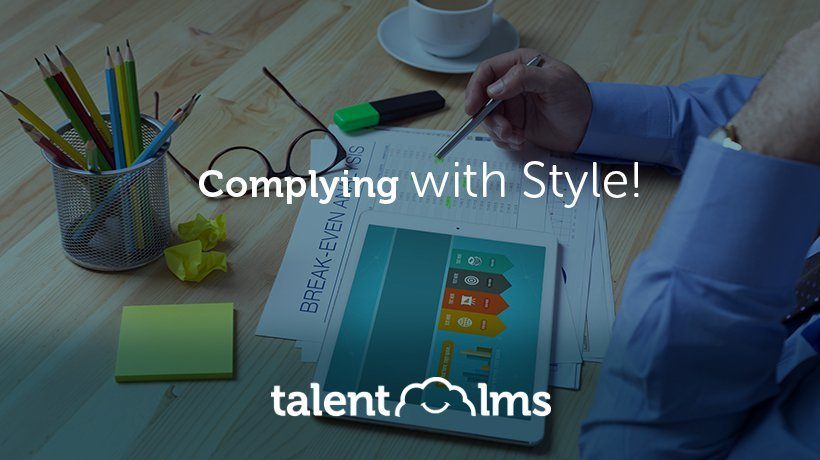Adhering To Compliance Standards, The TalentLMS Way!
What makes a software system is not only a good design, a powerful feature-set and good engineering. It’s also if it complies with legislation and rules that govern the world of software development. And in the case of TalentLMS, compliance standards are part of our DNA. If it wasn’t already blatantly obvious, in this article, we are going to talk about how TalentLMS deals with various compliance standards.
Mind you, we are not talking about using TalentLMS itself for compliance training, for which it is an excellent tool, by the way, and whose compliance training capabilities we have covered in previous articles here on eLearningIndustry.com, but about how the TalentLMS platform complies with global and state-mandated standards for software.
Specifically, we are going to cover two sets of compliance standards: the Web Accessibility-related ones (WAI/WCAG-2/Section 508/ADA), and those pertaining to electronic records (21 CFR part 11).
So how does TalentLMS fare with all these requirements? Let’s find out.
WCAG-WCAG-2-WAI-Section 508-ADA Compliance Standards
Web accessibility refers to the practice of making websites and web resources in general accessible (easy to use and interact with) for people with disabilities. Accessibility doesn’t require substantial changes or constraints to a site’s design, but primarily an awareness of the possible issues, and an adherence to several simple rules and guidelines when creating web content.
As for this section’s heading, well, it is not a tongue twister. It’s a bunch of web accessibility related acronyms and standards with which TalentLMS complies.
WAI stands for the Web Accessibility Initiative, a committee created by the World Wide Web Consortium (aka W3C -- the body responsible for most of the web’s standards). After much deliberation, WAI released the first version of their WCAG (Web Content Accessibility Guidelines) in 1999, which was followed by an updated set of recommendations (WCAG 2.0) about 10 years later.
Today, WCAG 2.0 is the de facto compliance standard for building accessible websites and is increasingly becoming de jure too, as governments adopt it wholesale as their official accessibility standard, especially for government run and/or funded websites.
Section 508, on the other hand, is a US law (technical an amendment to the Rehabilitation Act) that requires all federal government agencies to make their websites (and IT infrastructure in general) accessible to people with disabilities. Also US-related, ADA is the "Americans with Disabilities Act" of 1990, a law that "prohibits unjustified discrimination based on disability" at the workplace.
Any software vendor that wishes to sell software to the US, and especially to US government agencies and related organizations, has to comply with the above laws.
So how does TalentLMS do with all these?
The TalentLMS team has built the platform following the web-specific WCAG-2 guidelines, which also cover (most of) Section 508 and ADA requirements.
While there is no standard WCAG-2 certification process for websites and services (and no way to achieve 100% compliance with the standard without over-restricting the implementation of the resulting website or service), TalentLMS has nevertheless reached a high level of conformance with the standard.
This includes basic items, such as providing text alternatives for any non-text content (to make it accessible to people using screen-readers), to offering full keyboard accessibility, adaptable layouts, and content themes, and input assistance. Note that you will need to spend some time to ensure that your eLearning content is also accessible, as the platform’s accessibility capabilities are only part of the whole equation.
For a fuller breakdown of TalentLMS' WCAG-2 compliance, you can read our in-depth article in the Support space.
21 CFR Part 11 Compliance Standards
21 CFR part 11? Leave it to bureaucrats to come up with nice names for things. In any case, and since we are stuck with it, "21 CFR part 11" is a part of Title 21 of the Code of Federal Regulations on electronic records and electronic signatures (ERES).
"Part 11", as it’s known to friends, "defines the criteria under which electronic records and electronic signatures are considered trustworthy, reliable, and equivalent to paper records".
In plain English, part 11 is all about how you can build software, including websites, secure and reliable enough for its records to be considered analogous to paper records.
Understandably, this can be broken down to very many requirements, from the ability of a software to generate "complete copies of records in human readable and electronic form suitable for inspection, review and copying" to having an authentication system in place to only allow access to authorized individuals. TalentLMS easily adheres to these two compliance standards and many more, as you might expect.
For a rule by rule breakdown of how TalentLMS tackles 21 CFR part 11 compliance, read our article in the Support space.
Conclusion
In this article, we had a look at how TalentLMS handles various compliance standards that relate to Accessibility and Electronic Records, and especially the WCAG-2/Section 508/ADA and 21 CRF Part 11 sets of requirements and guidelines.
While some of those standards are US-driven, national governments from all around the world have adopted the same, or very similar, compliance standards and requirements in these areas, to which TalentLMS is automatically also compliant.









